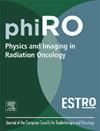应用双能计算机断层扫描和正电子发射断层扫描通过血液灌注和代谢研究头颈部肿瘤缺氧
IF 3.3
Q2 ONCOLOGY
引用次数: 0
摘要
背景与目的头颈癌(HNC)缺氧可以用正电子发射断层扫描(PET)使用18f -氟唑霉素-阿拉伯糖(FAZA)成像,但不常规使用。相比之下,氟脱氧葡萄糖(FDG) PET显示肿瘤代谢通常用于HNC患者的放射治疗(RT)。双能计算机断层扫描(DECT)可以生成碘浓度(IC)图,显示灌注血容量。在这里,我们探讨了如何使用PET衍生的FDG和DECT衍生的IC指标对HNC进行缺氧分类。材料与方法收集6例HNC患者在放疗前及放疗期间的DECT、FAZA、FDG PET/CT。采用FAZA肿瘤与肌肉(TMR)比值≥1.2进行缺氧分类。在总肿瘤体积(GTV)范围内,用IC标准差除以平均比值σICIC¯来模拟血液灌注,用最大FDG标准摄取值百分比(%SUVmax)来模拟代谢活性。分别计算模型血灌注和代谢的受试者工作特征(ROC),并用σICIC¯%SUVmax计算。灌注和代谢指标进一步应用于基于消耗和供应的缺氧(CSH)模型。结果结合血液灌注和代谢指标,roc曲线改善,AUC在0.9左右。具有高代谢活性和低模拟血灌注的gtv以低氧组分为主>;0.75支持CSH模型。结论结合DECT和FDG PET衍生指标建立的血液灌注和代谢模型作为潜在的缺氧生物标志物具有优越的预测能力,这可能与CSH模型有关。本文章由计算机程序翻译,如有差异,请以英文原文为准。
Exploring hypoxia in head and neck cancer through blood perfusion and metabolism using dual-energy computed tomography and positron emission tomography
Background and purpose
Hypoxia for head and neck cancer (HNC) can be imaged with positron emission tomography (PET) using 18F-Fluoroazomycin-arabinoside (FAZA) but is not used routinely. In contrast, fluorodeoxyglucose (FDG) PET visualizing tumor metabolism is routinely used in radiotherapy (RT) of HNC patients. Dual-energy computed tomography (DECT) can generate an iodine concentration (IC) map visualizing the perfused blood volume. Here, we explore how hypoxia can be classified for HNC using a PET derived FDG and a DECT derived IC metric.
Materials and methods
Corresponding DECT, FAZA, and FDG PET/CT for 6 HNC patients before and during RT were acquired. A FAZA tumor-to-muscle (TMR) ratio ≥1.2 was used for hypoxic classification. Within the gross tumor volume (GTV), the IC standard deviation over mean ratio, , was used to model blood perfusion and the percentage of maximum FDG standard uptake value (%SUVmax) was used for metabolic activity. Receiver Operating Characteristics (ROC) was performed for the modelled blood perfusion and metabolism individually and combined as . The perfusion and metabolism metrics were further applied in a consumption and supply-based hypoxia (CSH) model.
Results
ROC curves improved with AUC around 0.9 when combining the blood perfusion and metabolism metrics. GTVs with high metabolic activity and and low modelled blood perfusion was dominated by hypoxic fractions >0.75 supporting the CSH model.
Conclusions
Combining blood perfusion and metabolism modelled from DECT and FDG PET derived metrics resulted in a superior predictive power as potential hypoxia biomarkers which might be explained by a CSH model.
求助全文
通过发布文献求助,成功后即可免费获取论文全文。
去求助
来源期刊

Physics and Imaging in Radiation Oncology
Physics and Astronomy-Radiation
CiteScore
5.30
自引率
18.90%
发文量
93
审稿时长
6 weeks
 求助内容:
求助内容: 应助结果提醒方式:
应助结果提醒方式:


